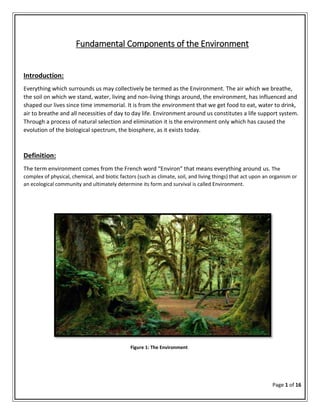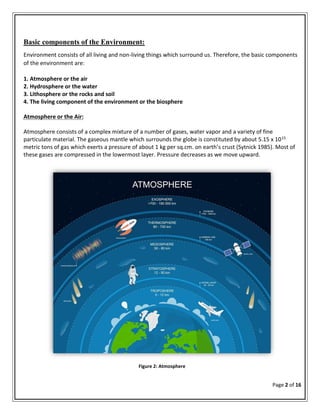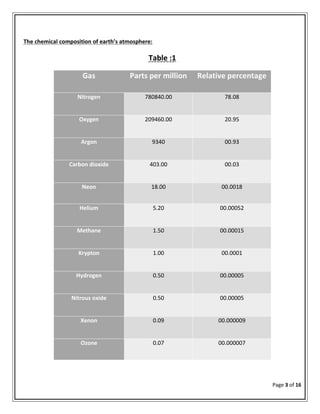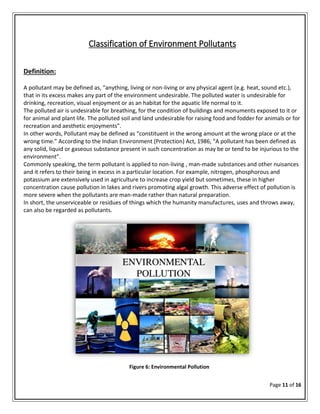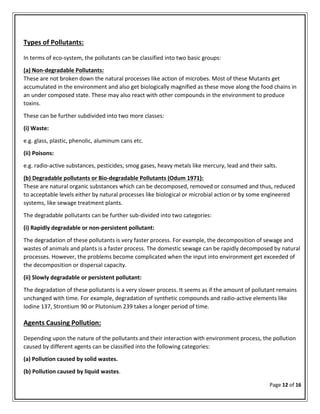Fundamental Components of the Environment and Environmental Pollutants
- 1. Page 1 of 16 Fundamental Components of the Environment Introduction: Everything which surrounds us may collectively be termed as the Environment. The air which we breathe, the soil on which we stand, water, living and non-living things around, the environment, has influenced and shaped our lives since time immemorial. It is from the environment that we get food to eat, water to drink, air to breathe and all necessities of day to day life. Environment around us constitutes a life support system. Through a process of natural selection and elimination it is the environment only which has caused the evolution of the biological spectrum, the biosphere, as it exists today. Definition: The term environment comes from the French word ŌĆ£EnvironŌĆØ that means everything around us. The complex of physical, chemical, and biotic factors (such as climate, soil, and living things) that act upon an organism or an ecological community and ultimately determine its form and survival is called Environment. Figure 1: The Environment
- 2. Page 2 of 16 Basic components of the Environment: Environment consists of all living and non-living things which surround us. Therefore, the basic components of the environment are: 1. Atmosphere or the air 2. Hydrosphere or the water 3. Lithosphere or the rocks and soil 4. The living component of the environment or the biosphere Atmosphere or the Air: Atmosphere consists of a complex mixture of a number of gases, water vapor and a variety of fine particulate material. The gaseous mantle which surrounds the globe is constituted by about 5.15 x 1015 metric tons of gas which exerts a pressure of about 1 kg per sq.cm. on earthŌĆÖs crust (Sytnick 1985). Most of these gases are compressed in the lowermost layer. Pressure decreases as we move upward. Figure 2: Atmosphere
- 3. Page 3 of 16 The chemical composition of earthŌĆÖs atmosphere: Table :1 Gas Parts per million Relative percentage Nitrogen 780840.00 78.08 Oxygen 209460.00 20.95 Argon 9340 00.93 Carbon dioxide 403.00 00.03 Neon 18.00 00.0018 Helium 5.20 00.00052 Methane 1.50 00.00015 Krypton 1.00 00.0001 Hydrogen 0.50 00.00005 Nitrous oxide 0.50 00.00005 Xenon 0.09 00.000009 Ozone 0.07 00.000007
- 4. Page 4 of 16 Hydrosphere or the water: The hydrosphere is a collective term given to all different forms of water. It includes all types of water resources such as oceans, seas, rivers, lakes, streams, reservoirs, glaciers and ground waters. The distribution of earthŌĆÖs water supply is shown in figure 3.1- Figure 3: Hydrosphere Figure 3.1: The distribution of water supply of the Earth.
- 5. Page 5 of 16 As can be seen, only 1 % of the total water supply is available as fresh water in the form of rivers, lakes, streams and ground water for human consumption and other uses. The extent of the use of available fresh water for various purposes is shown in the following figure 3.2- The major problem with global water supply is its non-uniform distribution, since people in areas with low precipitation often consume more than people in regions with more rainfall. Figure 3.2: Major use of fresh water Figure 3.3: Fresh water crisis
- 6. Page 6 of 16 The chemical composition of hydrosphere: Table :2 Water masses at Earth's surface Reservoir Volume (in cubic kilometers) Percent of total Oceans 1,338,000,000 96.5 Ice caps, glaciers, and permanent snow 24,064,000 1.74 Ground ice and permafrost 300,000 0.22 Groundwater (total) 23,400,000 1.69 Groundwater (fresh) 10,530,000 0.76 Groundwater (saline) 12,870,000 0.93 Lakes (total) 176,400 0.013 Lakes (fresh) 91,000 0.007 Lakes (saline) 85,400 0.006 Soil moisture 16,500 0.001 Atmosphere* 12,900 0.001 Swamp water 11,470 0.0008 Rivers 2,120 0.0002 Biota 1,120 0.0001 Total** 1,409,560,910 101.67 *As liquid equivalent of water vapor. **Total surpasses 100 percent because of upward rounding of individual reservoir volumes. Source: Adapted from Igor Shiklomanov's chapter "World Fresh Water Resources" in Peter H. Gleick (ed.), Water in Crisis: A Guide to the World's Fresh Water Resources, copyright 1993, Oxford University Press, New York, N.Y. Table made available by the United States Geological Survey.
- 7. Page 7 of 16 Lithosphere or the rocks and soil: The lithosphere consists of upper mantle and the crust. The crust is the earthŌĆÖs outer skin that is accessible to human. The crust consists of rocks and soil of which the latter is the important part of lithosphere. The earth is divided into layers as shown in figure 4.1- Figure 4: Internal structure of the Earth Figure 4.1: Layers of Earth
- 8. Page 8 of 16 The chemical composition of Lithosphere: Table :3 Major Elements Percent by Weight Percent by Volume Percent by Atoms Oxygen 46.6 93.8 62.6 Silicon 27.7 0.9 21.2 Aluminium 8.1 0.5 6.5 Iron 5.0 0.4 1.9 Calcium 3.6 1.0 1.9 Sodium 2.8 1.3 2.6 Potassium 2.6 1.8 1.4 Magnesium 2.1 0.3 1.8
- 9. Page 9 of 16 Biosphere: The biosphere refers to the realm of living organisms and their interactions with the environment (VIZ: atmosphere, hydrosphere and lithosphere). The biosphere is very large and complex and is divided into smaller units called ecosystems. Plants, animals and microorganisms which live in a definite zone along with physical factors such as soil, water and air constitute an ecosystem. Within each ecosystem there are dynamic inter relationships between living forms and their physical environment. The natural cycles operate in a balanced manner providing a continuous circulation of essential constituents necessary for life and this stabilizes and sustains the life processes on earth. These inter relationships manifest as natural cycles, (hydrologic cycle, Oxygen cycle, Nitrogen cycle, Phosphorous cycle and Sulphur cycle). The shape of the Earth is very close to that of an oblate spheroid, a sphere flattened along the axis from pole to pole. Figure 5: Biosphere
- 10. Page 10 of 16 The composition of Biosphere: Forests are the major components of biomes. They provide a variety of resources and services. About 82.3 million km2 worldwide is covered by trees of which about 50% are areas with a canopy cover of more than 25%. Table :4 Forest types Area (1000 km2) Evergreen 18 338.46 Deciduous 4 189.20 Mixed forest 9 930.10 Shrublands 23 343.16 Savannas 16 013.31 Grasslands 10 541.72 Other essential components are animals, micro-organisms and human beings who depend on plant to live. Figure 5.1: All components of Biosphere
- 11. Page 11 of 16 Classification of Environment Pollutants Definition: A pollutant may be defined as, ŌĆ£anything, living or non-living or any physical agent (e.g. heat, sound etc.), that in its excess makes any part of the environment undesirable. The polluted water is undesirable for drinking, recreation, visual enjoyment or as an habitat for the aquatic life normal to it. The polluted air is undesirable for breathing, for the condition of buildings and monuments exposed to it or for animal and plant life. The polluted soil and land undesirable for raising food and fodder for animals or for recreation and aesthetic enjoymentsŌĆØ. In other words, Pollutant may be defined as ŌĆ£constituent in the wrong amount at the wrong place or at the wrong time.ŌĆØ According to the Indian Environment (Protection) Act, 1986, ŌĆ£A pollutant has been defined as any solid, liquid or gaseous substance present in such concentration as may be or tend to be injurious to the environmentŌĆØ. Commonly speaking, the term pollutant is applied to non-living , man-made substances and other nuisances and it refers to their being in excess in a particular location. For example, nitrogen, phosphorous and potassium are extensively used in agriculture to increase crop yield but sometimes, these in higher concentration cause pollution in lakes and rivers promoting algal growth. This adverse effect of pollution is more severe when the pollutants are man-made rather than natural preparation. In short, the unserviceable or residues of things which the humanity manufactures, uses and throws away, can also be regarded as pollutants. Figure 6: Environmental Pollution
- 12. Page 12 of 16 Types of Pollutants: In terms of eco-system, the pollutants can be classified into two basic groups: (a) Non-degradable Pollutants: These are not broken down the natural processes like action of microbes. Most of these Mutants get accumulated in the environment and also get biologically magnified as these move along the food chains in an under composed state. These may also react with other compounds in the environment to produce toxins. These can be further subdivided into two more classes: (i) Waste: e.g. glass, plastic, phenolic, aluminum cans etc. (ii) Poisons: e.g. radio-active substances, pesticides, smog gases, heavy metals like mercury, lead and their salts. (b) Degradable pollutants or Bio-degradable Pollutants (Odum 1971): These are natural organic substances which can be decomposed, removed or consumed and thus, reduced to acceptable levels either by natural processes like biological or microbial action or by some engineered systems, like sewage treatment plants. The degradable pollutants can be further sub-divided into two categories: (i) Rapidly degradable or non-persistent pollutant: The degradation of these pollutants is very faster process. For example, the decomposition of sewage and wastes of animals and plants is a faster process. The domestic sewage can be rapidly decomposed by natural processes. However, the problems become complicated when the input into environment get exceeded of the decomposition or dispersal capacity. (ii) Slowly degradable or persistent pollutant: The degradation of these pollutants is a very slower process. It seems as if the amount of pollutant remains unchanged with time. For example, degradation of synthetic compounds and radio-active elements like Iodine 137, Strontium 90 or Plutonium 239 takes a longer period of time. Agents Causing Pollution: Depending upon the nature of the pollutants and their interaction with environment process, the pollution caused by different agents can be classified into the following categories: (a) Pollution caused by solid wastes. (b) Pollution caused by liquid wastes.
- 13. Page 13 of 16 (c) Pollution caused by gaseous wastes. (d) Pollution caused by wastes without weights. (a) Pollution caused by Solid wastes: The solid wastes includes the pollutants like garbage, rubbish, ashes, large wastes formed due to demolition and construction processes, dead animals wastes, agricultural wastes etc. Prom the above examples, it is clear that the solid wastes may be domestic and industrial in nature. (b) Pollution caused by liquid wastes: Oxygen cycle is nicely operated in aquatic system maintaining ecological balance. That is, the dissolved oxygen is used by aquatic living organisms for their respiration and in return, these liberate carbon dioxide. Carbon dioxide molecules are again used by green plants and algae in the process of photosynthesis. During photosynthesis, oxygen is again liberated to water which remains in dissolved state. However, if some organic matter (food for bacteria) enters the water course, then bacteria oxidize these materials consuming oxygen from water. At such a condition, if the process of re oxygenation is slower than the process of de-oxygenation, then the river will be devoid of life sustaining dissolved oxygen and aquatic living organisms will die. The most important source of organic pollutants is sewage which contains faecal matter, urine, kitchen washing and oil washings. Sewage also contains a large number of pathogenic and harmless bacteria. The strength of organic waste material of sewage is measured in terms of bio-chemical oxygen demand (B.O.D). The value is expressed in terms of mg. of oxygen per liter of waste for 5 days at 20C. If the volume of B.O.D. is below 1500 mg per liter, the sewage is termed as weak waste, if it is 4000 mg per liter it is medium and above this value it is termed as strong Waste. However, if liquid industrial wastes containing acids, alkalis and poisonous substances enter the river, the aquatic life is affected and self-purification system of water is impaired. Pesticides and herbicides which enter water may Kill some organisms or accumulate in fishes which, when consumed by man, pass on the chemicals giving rise to cumulative poisoning. (c) Pollution caused by Gaseous Wastes: The gaseous wastes include Carbon monoxide (CO), Sulphur dioxide (SO2), nitrogen dioxide (NO2), Ozone (O3) and smog gases (composed of a complex mixture of photochemical oxidation products of hydrocar- bons). These gases are more abundant in the atmosphere of industrial cities. (d) Pollution from Waste without weight: This type of pollution is also known as pollution by energy waste; Wastes without weight may be of the following types: (i) Radio-active (ii) Heat
- 14. Page 14 of 16 (iii) Noise (i) Radio-active Substance: Despite of all possible precautions in the functioning and maintenance of nuclear reactors, it is seen that minute quantity of radio-active waste escapes out into the environment. From the mining operation of the uranium to the use and final disposal of wastes from the reactor, radio-active materials continuously escape out into the environment. Besides, a lot of radio-active wastes enter into environment during the nuclear tests. (ii) Heat: A large quantity of waste heat energy is dissipated into environment by the way of hot liquid streams or hot gases released by industries and automobiles. (iii) Noise: The unwanted sound is known as noise. This sources of noise for the general public are the machines in the industry, traffic noise, indiscriminate use of transistor, radios, public address systems, etc. Classification of Pollution: Pollution can be classified according to the environment (air, water, and soil) in which it occurs or according to the type of pollutant (lead, mercury, carbon dioxide, solid waste, noise, biocide, heat, etc.) by which pollution is caused. Sometimes, pollution is made to classify into two broad categories: 1. Natural Pollution: It originates from the natural process. 2. Artificial or Man-made Pollution: It originates artificially by the interaction in between humanity and environment. Different types of pollutions are as follows: 1. Air pollution 2. Water pollution 3. Terrestrial pollution 4. Noise pollution 5. Radiation pollution 6. Thermal pollution
- 15. Page 15 of 16 7. Industrial pollution General Effects of Pollution: Each and every component of environment is influenced by pollution in a number of ways. The impact of pollution on some biotic and abiotic components may be discussed as below: (i) Effect on Plants: Photo-chemical smogŌĆÖs, sulphur-dioxide (obtained from copper and lead smelter) and hydrogen fluoride (obtained from fertilizer manufacturing and aluminum reduction) cause injury to the plants and thereby reduce their growth and vegetation. In some cases, even when pollution levels have been not high enough to produce noticeable injury, the retardation in growth rate may occur. On the whole, the pollutants (air or water pollutant or radiation) bring about complex changes in the plant eco-system, having effects on one species leading to effects on the other. (ii) Effect on Animals: Air pollutants cause eye and respiratory irritation in animals as well as in human beings. Water pollutants can endanger aquatic life killing millions of fishes and other animals every year. Sewage, toxic chemicals and diseased animals can make water unfit for use by farm animals. There are some types of pollutions known to have adverse effects on animals at levels that do not appear to affect human health. Thermal pollution in rivers and lakes can kill fishes. Pesticide levels can reduce reproduction rates through mechanisms like interference in calcium metabolism. (iii) Effect on Human Beings: Human beings are probably the most concerned about the direct and indirect effects of pollution. Sufficiently high levels of pollutants are toxic or even lethal to every human being, although there is a wide range of sensitivities among the human population. For example, tartar emetic (antimony potassium tartrate) can be lethal at doses as low as 130 mg but some persons have survived doses as high as 15 gm. On the other hand, sufficiently low doses appear to have no toxicological effects. It is seen that many diseases are water borne and can be checked through the purification of municipal and individual water supplies. Still, the drinking water of most of the worldŌĆÖs population is considerably less safe than that of the developed nations due to inadequacies in public health programs. (iv) Effect on materials: Pollutants can cause deterioration of materials and constructions. Air pollutants like SO2 and H2S04 gas can corrode metals and building materials increasing the frequency of repair and replacement. Water pollutants, like suspended particles or dissolved inorganic compounds can also adversely affect pumps, industrial
- 16. Page 16 of 16 equipmentŌĆÖs and bridges. The supersonic aircrafts capable of producing sonic booms with pressures of over 100 M/m2, even its noise, can damage buildings and break windows. (v) Synergism and Antagonism: Multiple exposure of pollutants within or in between classes, may include synergistic or antagonistic biological effects. In many cases, the combined effects of two or more pollutants are more severe or even qualitatively different from the individual effects of separate pollutants. Such a phenomenon is known as synergism. For example, the toxicity of sulphur dioxide can be further increased in the presence of aerosol of soluble salts of ferrous (Iron), manganese and vanadium. Such an increase in toxicity is known as potentiation. In some cases, the combined effects of two pollutants is less rather than more severe, and this situation is referred to as antagonism. For example, the cyanides in industrial wastes are quite poisonous to aquatic life and in presence of zinc or cadmium these are extremely poisonous (a synergetic effect) apparently, due to the formation of complexes. However, in presence of nickel, a nickel-cyanide complex is formed whose toxicity is comparatively low. References: 1. http://www.yourarticlelibrary.com/essay/lithosphere-its-physical-characteristics- compositions-and-other-details/28151 2. http://www.preservearticles.com/education/what-are-the-main-components-of-the- environment/20966 3. https://www.britannica.com/science/hydrosphere 4. http://www.yourarticlelibrary.com/ecology/environment-13-most-important-components- of-environment-discussed/9870 5. http://www.environmentalpollution.in/pollution/environmental-pollution-pollutants- types-agents-classification-general-effects/301
